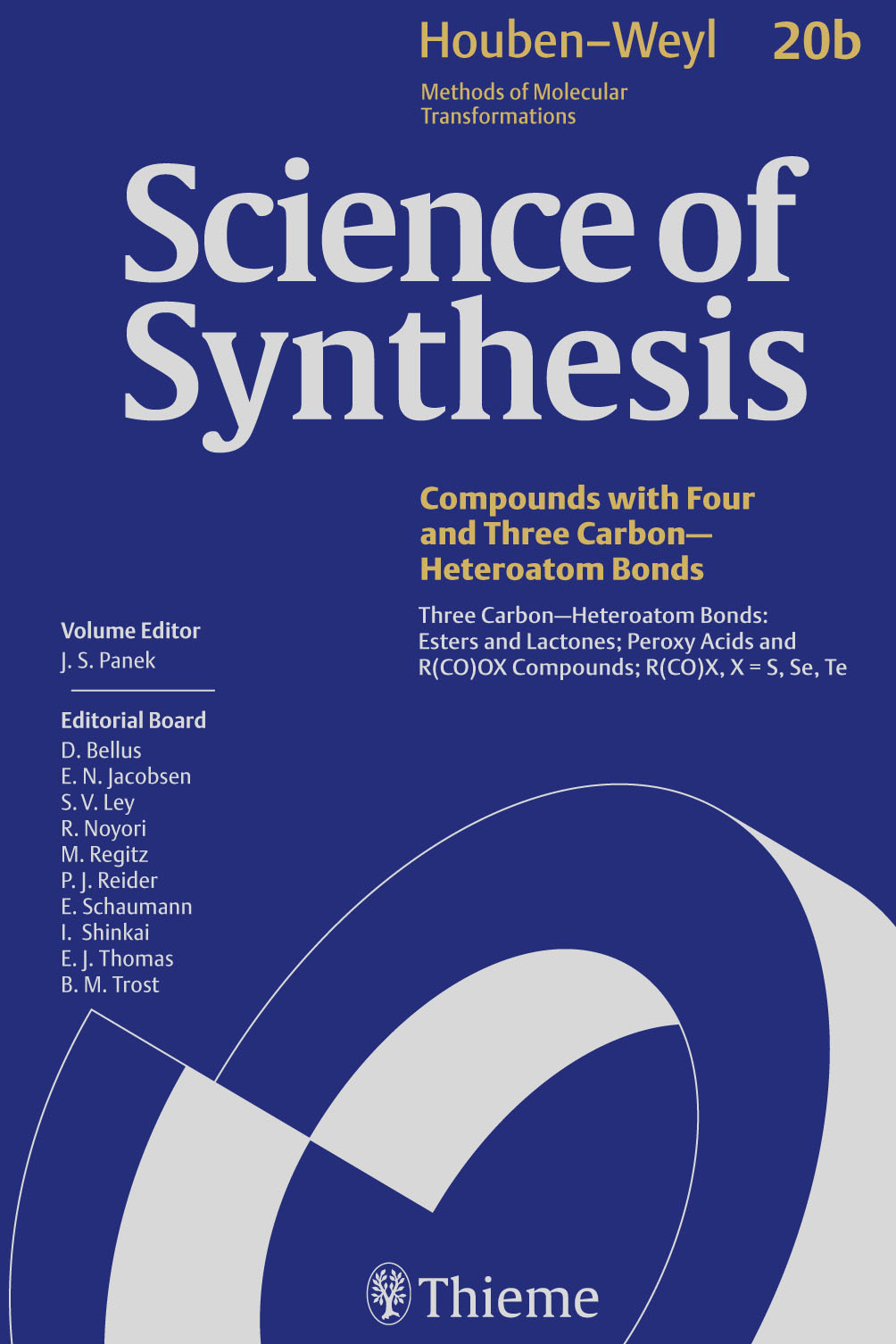You are using Science Of Synthesis as a Guest.
Please login to access the full content or check if you have access via20.5.14.1.4.3 Variation 3: Horner–Wadsworth–Emmons Reaction
Please login to access the full content or check if you have access via
Vanderwal, C. D.; Jacobsen, E. N., Science of Synthesis, (2007) 20, 1322.
The use of phosphonate-stabilized carbanions to generate alk-2-enoic acid esters from aldehydes or ketones has seen extensive use in synthesis.[59] Advantages of this method include the ready accessibility of the required phosphonates, either from commercial sources or by the Arbuzov reaction of α-halo esters, the water solubility of the reaction byproducts, and the availability of protocols for the selective generation of either geometrical isomer in many synthetic contexts. The most common conversion of an aldehyde into an E-alk-2-enoic acid ester is exemplified by the homologation of aldehyde 98 into ester 100 using phosphonate 99 (Scheme 19).[60] An important modification of the Horner–Wadsworth–Emmons reaction makes use of the combination of a Lewis acid and an amine base to generate the phosphonate-stabilized carbanion under mildly basic conditions; this allows for the use of both carbonyl substrates and phosphonate nucleophiles that bear base-sensitive groups. For example, aldehyde 101 is subject to base-mediated epimerization under standard alkenation conditions with phosphonate 102; however, with the use of a combination of lithium chloride and N,N-diisopropylethylamine, alk-2-enoic acid ester 103 is formed in high yield.[61] The control of alkene geometry is of high importance in these reactions, and thus reagents that selectively form the thermodynamically less stable Z-isomer have proven very useful. The use of the bis(trifluoroethyl)phosphonate ester 105 constitutes a great advance in the selective formation of Z-alk-2-enoic acid esters,[62] as exemplified by the conversion of dienal 104 into isomerically pure ester 106.[63] Another important method for the selective generation of Z-products makes use of diarylphosphonoacetic acid esters.[64–66] The use of standard Horner–Wadsworth–Emmons procedures in intramolecular contexts can be used to generate cyclic alk-2-enoic acid esters, as in the cyclization of 107 to macrocycle 108.[67] Ketones can also be alkenated, albeit with higher temperature demands (e.g., the reaction of 109 to 110).[68]
Meeeee 88 Mee Meeeee–Meeeeeeee–Meeeee Meeeeeee eee eee Meeeeeeee ee Mee-8-eeeee Meee Meeeee[88,88,88,88,88]
Meeeeeeeeeee Meeeeeeee
88-eeee-Meeee 8-Meeeee (8M,8M,8M,8M,88M)-88-Meeeeeeeee-8,8-eeeeeeeeeeeeee-8,8,8,8-eeeeeeeeeeeeee (888); Meeeeee Meeeeeeee:[88]
Me e eeee ee eeeeeeeeeee 88 (888 ee, 8.88 eeee) ee MMM (8.8 eM) ee 8°M eee eeeee 8.88 M MeMe ee eeeeee (8.88 eM, 8.88 eeee). Mee eeeeeeee eee eeeeeee eee 88 eee ee 8°M eee eeee eeeeeee ee eeee ee eeeeeee eeeeeeeeeee, eee e eeee ee eeeeeeee 88 (88.8 ee, 8.88 eeee) ee MMM (8.8 eM) eee eeeee. Mee eeeeeeee eee eeeeeee e eeeeeee 8 e ee eeeeeee eeeeeeeeeee, eee e eM 8 eeeeee eeee eee eeeee. Mee eeeeeeeee eeeeeee eee eeeeeeeee eeee MeMMe, eee eee eeeeeee eeeeeeee eeee eeeee (Me8MM8) eee eeeeeeeeeeee. Mee eeeee eeeeeee eee eeeeeeee ee eeeeeeeeeeeeee (eeeeee eee, eeeeee/MeMMe 8:8) ee eeeeee eeee eeeee 888; eeeee: 88.8 ee (88%).
References
| [59] | Meeeeeeee, M. M., Me., Mee. Meeee. (M. M.), (8888) 88, 88. |
| [60] | Meeeeee, M.; Meeeeeeee, M.; Meeee, M., Meeeeeeeeee, (8888) 88, 8888. |
| [61] | Meeeeeeeee, M. M.; Meee, M.; Meeee, M. M.; Meeeeeeee, M. M.; Meeeeeee, M.; Meeee, M. M.; Meeee, M., Meeeeeeeeee Meee., (8888) 88, 8888. |
| [62] | Meeee, M. M.; Meeeeee, M., Meeeeeeeeee Meee., (8888) 88, 8888. |
| [63] | Meeeee, M. M.; Meeeeeee, M. M.; Meeeeee, M. M.; Mee, M. M.; Meeeeee, M., Meeeeeeeeee, (8888) 88, 8888. |
| [64] | Meee, M., M. Mee. Meee., (8888) 88, 8888. |
| [65] | Meee, M., M. Mee. Meee., (8888) 88, 8888. |
| [66] | Meee, M., M. Mee. Meee., (8888) 88, 8888. |
| [67] | Mee, M.; Me, M., Meeeeeeeeee Meee., (8888) 88, 8888. |
| [68] | Meeeeeeeee, M.; Meeee, M. M.; Meeeeeeeee, M. M. M., Meeeeeeeeee Meee., (8888) 88, 888. |
Meeeeee Meeeeeeeeee
- 8.Meeeee-Meee, (8888) 8/8e, 888.
- 8.Meeeee-Meee, (8888) 8/8e, 888.
- 8.Meeeee-Meee, (8888) 8/8e, 888.
- 8.Meeeee-Meee, (8888) M 88-8, 888.









